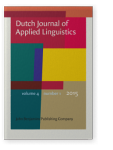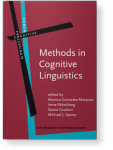Dirk Speelman
List of John Benjamins publications for which Dirk Speelman plays a role.
2015 Usage-related variation in the referential range of blue in marketing context Sensory Perceptions in Language and Cognition, Caballero, Rosario and Carita Paradis (eds.), pp. 20–43 | Article
The paper explores language-internal variation in the referential meaning of the lexical form blue. Taking a usage-based cognitive approach, we analyze the referential range of blue in several marketing contexts from a semasiological and an onomasiological perspective. The study develops an… read more
2015 The corpus-based identification of cross-lectal synonyms in pluricentric languages International Journal of Corpus Linguistics 20:1, pp. 54–80 | Article
This article discusses a corpus-based method for the automatic identification of synonyms across different varieties of the same language. This method, based on the paradigm of distributional semantics, quantifies semantic similarity on the basis of contextual similarity in two comparable corpora.… read more
2015 Lectal constraining of lexical collocations: How a word’s company is influenced by the usage settings Constructions and Frames 7:1, pp. 1–46 | Article
Adopting a corpus-based approach, lexical collocations are reconsidered from a lectal perspective. Analyzing adjective-noun collocations, it will be shown that lexical collocations are conditioned by the language settings in which they are used. These lectal constraints do not only apply to lexical… read more
2015 English-only job advertising in the Low Countries: The impact of job-related and company-related predictors Dutch Journal of Applied Linguistics 4:1, pp. 6–20 | Article
This paper presents a multifactorial quantitative corpus-based analysis of the distribution of English-only ads in the Low Countries. The dataset consists of approximately one thousand job ads, published in Vacature (a Belgian Dutch job ad magazine) and Intermediair (a Netherlandic Dutch job ad… read more
2015 Cross-linguistic variation in metonymies for PERSON: A Chinese-English contrastive study Review of Cognitive Linguistics 13:1, pp. 220–256 | Article
This paper investigates metonymies for person in Chinese and English in the framework of Cognitive Linguistics with an emphasis on cross-linguistic variation. Our central goal is to highlight the important role of cultural elements on the use of metonymy. Three main types of cross-linguistic… read more
2014 Referential meaning in basic and non-basic color terms Colour Studies: A broad spectrum, Anderson, Wendy, Carole P. Biggam, Carole Hough and Christian Kay (eds.), pp. 323–338 | Article
The chapter presents a linguistic analysis of the referential meanings in the semasiological structure of basic and non-basic color terms in a specific usage situation such as marketing. Although most linguistic studies share the assumption about the central role of the reference-related aspects in… read more
2014 Clustering for semantic purposes: Exploration of semantic similarity in a technical corpus Lexical semantic approaches to terminology, Faber, Pamela and Marie-Claude L'Homme (eds.), pp. 279–303 | Article
This paper presents an innovative approach, within the framework of distributional semantics, for the exploration of semantic similarity in a technical corpus. In complement to a previous quantitative semantic analysis conducted in the same domain of machining terminology, this paper sets out to… read more
2014 Dutch causative constructions: Quantification of meaning and meaning of quantification Corpus Methods for Semantics: Quantitative studies in polysemy and synonymy, Glynn, Dylan and Justyna A. Robinson (eds.), pp. 205–221 | Article
This chapter is a multivariate corpus-based study of two near-synonymous periphrastic causatives with doen and laten in Dutch. Using multiple logistic regression and classification trees, the study explores the conceptual differences between the constructions. The results support the existing… read more
2014 Logistic regression: A confirmatory technique for comparisons in corpus linguistics Corpus Methods for Semantics: Quantitative studies in polysemy and synonymy, Glynn, Dylan and Justyna A. Robinson (eds.), pp. 487–533 | Article
This text offers an introduction to binary logistic regression, a confirmatory technique for statistically modelling the effect of one or several predictors on a binary response variable. It is explained why logistic regression is exceptionally well suited for the comparison of near-synonyms in… read more
2014 Spurious effects in variational corpus linguistics: Identification and implications of confounding International Journal of Corpus Linguistics 19:4, pp. 478–504 | Article
As repositories of spontaneously realized language, corpora generally have an uncontrolled and unbalanced structure where all variables operate simultaneously. Consequently, a variable’s real effect can be concealed when studied in isolation because of the exclusion of the impact of other… read more
2014 Core vocabulary, borrowability and entrenchment: A usage-based onomasiological approach Diachronica 31:1, pp. 74–105 | Article
It is often claimed in contact linguistics that core vocabulary is highly resistant to borrowing. If we want to test that claim in a quantitative way, we need both a quantitative measure of coreness and a method for quantifying borrowability. We suggest here a usage-based operationalization of… read more
2013 ‘Keywords Method’ versus ‘Calcul des Spécificités’: A comparison of tools and methods International Journal of Corpus Linguistics 18:4, pp. 536–560 | Article
This paper explores two tools and methods for keyword extraction. As several tools are available, it makes a comparison of two widely used tools, namely Lexico3 (Lamalle et al. 2003) and WordSmith Tools (Scott 2013). It shows the importance of keywords and discusses recent studies involving keyword… read more
2011 Changing the world vs. changing the mind: Distinctive collexeme analysis of the causative construction with doen in Belgian and Netherlandic Dutch Language Variation - European Perspectives III: Selected papers from the 5th International Conference on Language Variation in Europe (ICLaVE 5), Copenhagen, June 2009, Gregersen, Frans, Jeffrey K. Parrott and Pia Quist (eds.), pp. 111–122 | Article
2011 Variation in the (non)metonymic capital names in Mainland Chinese and Taiwan Chinese Metaphor and the Social World 1:1, pp. 90–112 | Article
This paper examines the (non)metonymic usage of capital names in news articles from Mainland Chinese and Taiwan Chinese and shows that this phenomenon is actually more complex than might have been expected. We annotated capital names extracted from a self-built news corpus with insights from… read more
2009 Lexical patterning in a construction grammar: The effect of lexical co-occurrence patterns on the inflectional variation in Dutch attributive adjectives Constructions and Frames 1:1, pp. 87–118 | Article
This paper compares two measures that quantify lexical preference patterns in the area of Construction Grammar, namely, collostructions and (construction-internal) collocations (as conceived by Stefan Th. Gries and Anatol Stefanowitsch). Starting from a case study, inflectional variation in Dutch… read more
2008 The distribution of T/V pronouns in Netherlandic and Belgian Dutch Variational Pragmatics: A focus on regional varieties in pluricentric languages, Schneider, Klaus P. and Anne Barron (eds.), pp. 181–209 | Article
2008 Prosodic and syntactic-pragmatic mechanisms of grammatical variation: The impact of a postverbal constituent on the word order in Dutch clause final verb clusters International Journal of Corpus Linguistics 13:2, pp. 194–224 | Article
This paper reports on a quantitative corpus-based study of the impact of a postverbal constituent (PVC) on the choice of word order in Dutch written clause final verb clusters consisting of a participle and an auxiliary verb. The study verifies the results of previous research by analyzing the… read more
2007 A case for a cognitive corpus linguistics Methods in Cognitive Linguistics, Gonzalez-Marquez, Monica, Irene Mittelberg, Seana Coulson and Michael J. Spivey (eds.), pp. 149–169 | Article
















